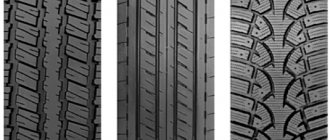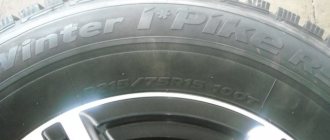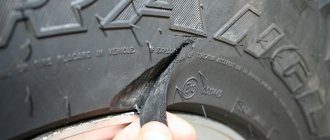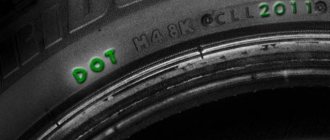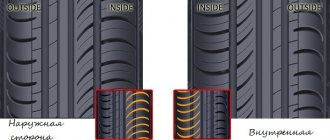Tire load index is a conventional numerical designation that shows what mass load a tire can withstand in long-term operation. This information is necessary in order to choose the right tires, and thereby ensure a safe and comfortable driving experience. To decipher the tire load index, use a table that shows the numerical designations of the index and the normal values of the mass that corresponds to them.
Load value (MAX LOAD) and tire pressure
Next, we will provide you with such a table, as well as provide information about the speed index , which is also important when choosing a tire. You can read additional information about the symbols on tires.
Load Index
The load index for passenger tires is usually expressed as a two- or three-digit number, which appears immediately after the seat diameter in the marking. It can also be called the “tire load-bearing capacity index” and means the maximum load capacity for which the tire is designed during operation.
Each size for a passenger car, according to ETRTO (European Tire and Rim Technical Organization) standards, can have two load indexes assigned to it - standard and increased . So, for example, a size 205/55R16 might have a load index of 91, which allows one tire to carry a load of 615 kg, or 94, which equals 670 kg per tire.
Increased load index
An increased load index in the tire marking is necessarily accompanied by an additional designation - XL, extraload or reinforced.
Such additional marking of increased load capacity is often interpreted by drivers as an increased strength indicator of the tire, i.e. A tire marked XL (extraload, reinforced) has a stronger sidewall. However, this is just a common misconception, and an increased load index does not in any way protect the tire from sidewall tearing or tread damage during operation.
Marking features
It is worth considering that ETRTO fixes tire parameters for the European market. There are other standards for North America; they are similar in many ways, but the North American ones have some peculiarities.
For example, the Latin letter “P” (the initial letter in the word “passenger” - passenger), which may mean that the tire uses a load index less than the standard:
P265/65 R17 110H (load - 1060 kg per tire)
265/65 R17 112H (load - 1120 kg per tire)
When choosing a size with the letter “P”, first you need to check the technical documentation of the car and understand whether this reduced load index .
Tire manufacturing date
Figure No. 6. Date of manufacture of tires.
Another marker present on every tire is the date of manufacture of the product. The presence of this abbreviation is due to the fact that during long-term storage, products lose their running properties due to a decrease in elasticity indicators, and, accordingly, a deterioration in such a parameter as the speed index.
You can determine the date of manufacture of tires using a three- or four-digit code located in a rectangular frame on the side of the product. The marking, which includes 3 digits, indicates that the tire was produced before 2000. If the abbreviation consists of 4 digits, then the driver can understand that the product was released after 2000. In addition, the first 2 digits of the marker indicate the week of issue, and the second - its year. Thus, sets of tires with the “1517” marker were released in April 2022.
Dual load index
In addition, you can now find another designation that complements the load index and came from the North American market - LT (“lighttruck” - light truck or pickup). It is also added to the beginning of the size and indicates that this size has an increased load index, expressed as a double number.
Example: LT265/65 R17120/117S.
This special marking of a dual load index means that for vehicles with four wheels on two axles, the load on the tire is calculated according to the first, largest index. And if the car has six wheels with two axles (dual tires for the rear axle), then you need to take the second, smallest index.
Example:
- For a standard car with tire size LT265/65 R17 120/117S, you need to take the index 120 - this is 1400 kg per tire, and the maximum weight that such a car can carry will be 1400 x 4 = 5600 kg.
- For a car with dual tires on the rear axle and tire size LT265/65 R17120/117S, you need to take index 117 - this is 1285 kg per tire, maximum weight - 1285 x 6 = 7710.
Thus, a car with dual tires on the rear axle will be able to carry more weight, even using the smaller tire size index.
A similar use of dual load index sizes is also found in the ETRTO standards for tire sizes intended for use on minibuses or small trucks (weighing up to 6 tons). But in this case it is accompanied by the Latin letter “C” (commercial) and looks like this: 225/60 R16C105/103T.
Decoding
The easiest way is to calculate the maximum load using the table we posted above.
Managers in car tire stores should also be savvy in deciphering indexes. Pay attention to the indexes recommended by the car manufacturer - they should be indicated in the car's operating instructions. The greater the difference in indexes between the tires you selected and those recommended by the manufacturer, the less comfort you will feel behind the wheel.
Tires for trucks are marked with two load indices. This is due to the fact that trucks often ride on dual wheels. And in this case, the double designation shows the load when using one or two wheels. There are no other differences in the tire load index between passenger cars and trucks.
Speed index
The speed index (or speed category) is a conditional indicator indicating the maximum speed that a tire can withstand. Speed indices are designated in Latin letters from A (minimum, A1 = 5 km/h) to Y (maximum, 300 km/h). For passenger cars, the following common speed indices can be distinguished:
- Standard: T(190 km/h), N (210 km/h)
- High speed: V(240 km/h), W (270 km/h), Y (300 km/h)
Off-road and commercial tires, as a rule, have lower speed ratings: Q (160 km/h), R (170 km/h), S (180 km/h).
Winter tires, depending on the type, can have a low speed index Q (160 km/h, for studded ones) and a fairly high W (270 km/h, for non-studded winter tires of the Central European type).
Some high-speed tires have a speed rating with a category even higher than that specified in the tire size. For example, size 325/25 ZR20 (101Y), where the speed index looks like this - ZR(Y), allows you to reach speeds of over 300 km/h.
Speed index not specified
Sometimes you can find tires where the speed index is not indicated . A similar situation occurred in the past, but with the latest changes in technical standards, tires without a speed index (and, as a rule, without a load index) were banned from sale in the Russian Federation.
Why were similar tires produced in the past?
Some sports cars received specially prepared tires that could be installed exclusively on that sports car. In this case, already at the development stage, tire engineers calculated and included in the tire the maximum weight of a sports car, and the speed index was limited only by the maximum speed of the corresponding car. And there was no need to indicate speed and load indices, since the formula “special tire - only for one special car” worked. With the development of the sports car segment, such “uniqueness” disappeared and could mislead a potential buyer. Therefore, it was decided to provide each tire size with a corresponding speed and load index.
Which tire to choose?
When the car is truly fast and powerful, the choice of tires should never be limited by size alone
You should choose tires based on the type of car, its price, and your driving style. Remember that tires must be individually selected (adapted) to a specific car, since they have a direct impact on the ride, handling and braking of the car. It is also important not to forget that you cannot use tires with different speed and load indexes on different axles.
Information about the best tires for your vehicle can be found in your vehicle's manual, on a placard that may be mounted on the driver's pillar, or elsewhere on your vehicle. Also, any online store selling tires can be a source of information, on whose website you can make a selection of tires specifically for your car.
The combination of load index and speed index is especially important in supercars and any sports cars. You cannot purchase any tires for these vehicles. The fact is that at high speed one car may begin to lose traction (at high speed the car may begin to “bounce”), as a result of which the load on the tires may decrease somewhat, while another, for example, having sports spoilers, can exert an additional load on each tire with a force of several tens of kilograms. As a result, even if the cars weigh the same, when driving at 200 km/h, one car's tires will experience less load than the other car's tires.
see also
A large amount of information is hidden in the letters on the tires: instructions for reading
Selection of speed and load indices
Taking into account the fact that the load index is “attached” to the size, the consumer, when choosing the tire size allowed for installation, automatically receives the required load index. In some cases, you need to check in the technical documentation for the car whether a size with increased load capacity is required (XL, extraload, reinforced) or immediately opt for the permitted sizes with a large load index. Moreover, some tire manufacturers (for example, MICHELIN) already produce most tires in sizes with a higher load capacity.
The situation with the speed index is more complicated. According to current technical standards, the driver must choose summer tires to replace those that were installed on the assembly line with a speed index not lower than the original equipment.
For example, you cannot choose a tire with a speed index of T (190 km/h) to replace a tire with a speed index of H (210 km/h), but you can choose high-speed tires with a speed index of V (240 km/h), W (270 km/h) /h) and higher.
Decoding table for cars, crossovers and SUVs
The load index for cars is calculated based on two basic parameters: its weight and the maximum permissible load. To simplify calculations, you can use the data in special tables (shown below).
For passenger cars
The load index for passenger cars has a 2-digit display and ranges between the numbers 63 and 90.
The larger this parameter, the greater the thickness, stiffness or weight of the tire.
Consequently, fuel consumption and noise levels when driving increase.
As the index decreases, the tires become softer and lighter, but wear out faster.
| Load Index | Weight Limit |
| 63 | 272 |
| 64 | 280 |
| 65 | 290 |
| 66 | 300 |
| 67 | 307 |
| 68 | 315 |
| 69 | 325 |
| 70 | 335 |
| 71 | 345 |
| 72 | 355 |
| 73 | 365 |
| 74 | 375 |
| 75 | 387 |
| 76 | 400 |
| 77 | 412 |
| 78 | 425 |
| 79 | 437 |
| 80 | 450 |
| 81 | 462 |
| 82 | 475 |
| 83 | 487 |
| 84 | 500 |
| 85 | 515 |
| 86 | 530 |
| 87 | 545 |
| 88 | 560 |
| 89 | 580 |
| 90 | 600 |
Tire load index table for crossovers
Unlike the indicator for passenger cars, the load index for crossovers is expressed as a 2 or 3-digit numerical parameter. It can be viewed next to the bore diameter data.
Rubber for crossovers, as a rule, has a higher load capacity index and is accompanied by the XL mark. The presence of such an inscription indicates that the tire is more durable.
In most cases, the load index for such cars is in the range of 90-105.
| Load Index | Weight Limit |
| 90 | 600 |
| 91 | 615 |
| 92 | 630 |
| 93 | 650 |
| 94 | 670 |
| 95 | 690 |
| 96 | 710 |
| 97 | 730 |
| 98 | 750 |
| 99 | 775 |
| 100 | 800 |
| 101 | 825 |
| 102 | 850 |
| 103 | 875 |
| 104 | 900 |
| 105 | 925 |
For SUVs
In the case of SUVs, the load index will be slightly higher - in the range of 105 to 125. This means that the weight per wheel can be from 925 to 1650 kg.
| Load Index | Weight Limit |
| 105 | 925 |
| 106 | 950 |
| 107 | 975 |
| 108 | 1000 |
| 109 | 1030 |
| 110 | 1060 |
| 111 | 1090 |
| 112 | 1120 |
| 113 | 1150 |
| 114 | 1180 |
| 115 | 1215 |
| 116 | 1250 |
| 117 | 1285 |
| 118 | 1320 |
| 119 | 1360 |
| 120 | 1400 |
| 121 | 1450 |
| 122 | 1500 |
| 123 | 1550 |
| 124 | 1600 |
| 125 | 1650 |
For trucks
For trucks, the same index table is used. The difference is that for such machines the parameter starts at 125 or more.
| Load Index | Weight Limit | Load Index | Weight Limit |
| 125 | 1650 | 163 | 4875 |
| 126 | 1700 | 164 | 5000 |
| 127 | 1750 | 165 | 5150 |
| 128 | 1800 | 166 | 5300 |
| 129 | 1850 | 167 | 5450 |
| 130 | 1900 | 168 | 5600 |
| 131 | 1950 | 169 | 5800 |
| 132 | 2000 | 170 | 6000 |
| 133 | 2060 | 171 | 6150 |
| 134 | 2120 | 172 | 6300 |
| 135 | 2180 | 173 | 6500 |
| 136 | 2240 | 173 | 6700 |
| 137 | 2300 | 175 | 6900 |
| 138 | 2360 | 176 | 7100 |
| 139 | 2430 | 177 | 7300 |
| 140 | 2500 | 178 | 7500 |
| 141 | 2575 | 179 | 7750 |
| 142 | 2650 | 180 | 8000 |
| 143 | 2725 | 181 | 8250 |
| 144 | 2800 | 182 | 8500 |
| 145 | 2900 | 183 | 8750 |
| 146 | 3000 | 184 | 9000 |
| 147 | 3075 | 185 | 9250 |
| 148 | 3150 | 186 | 9500 |
| 149 | 3250 | 187 | 9750 |
| 150 | 3350 | 188 | 10000 |
| 151 | 3450 | 189 | 10300 |
| 152 | 3550 | 190 | 10600 |
| 153 | 3650 | 191 | 10900 |
| 154 | 3750 | 192 | 11200 |
| 155 | 3875 | 193 | 11500 |
| 156 | 4000 | 194 | 11800 |
| 157 | 4125 | 195 | 12150 |
| 158 | 4250 | 196 | 12500 |
| 159 | 4375 | 197 | 12850 |
| 160 | 4500 | 198 | 13200 |
| 161 | 4625 | 199 | 13600 |
| 162 | 4750 |
For commercial vehicles
In the case of special commercial vehicles, tires with an index of up to 129 can be used.
When choosing, it is recommended to choose those tires whose load capacity is greater than the parameter declared by the manufacturer.
Such a reserve is necessary to increase service life and, accordingly, save money.
Other load index indicators
They are rarely used in road transport, but you need to know about them.
| Load Index | Weight Limit | Load Index | Weight Limit |
| 0 | 45 | 33 | 115 |
| 1 | 46,2 | 34 | 118 |
| 2 | 47,5 | 35 | 121 |
| 3 | 48,7 | 36 | 125 |
| 4 | 50 | 37 | 128 |
| 5 | 51,5 | 38 | 132 |
| 6 | 53 | 39 | 136 |
| 7 | 54,5 | 40 | 140 |
| 8 | 56 | 41 | 145 |
| 9 | 58 | 42 | 150 |
| 10 | 60 | 43 | 155 |
| 11 | 61,5 | 44 | 160 |
| 12 | 63 | 45 | 165 |
| 13 | 65 | 46 | 170 |
| 14 | 67 | 47 | 175 |
| 15 | 69 | 48 | 180 |
| 16 | 71 | 49 | 185 |
| 17 | 73 | 50 | 190 |
| 18 | 75 | 51 | 195 |
| 19 | 77,5 | 52 | 200 |
| 20 | 80 | 53 | 206 |
| 21 | 82,5 | 54 | 212 |
| 22 | 85 | 55 | 218 |
| 23 | 87,5 | 56 | 224 |
| 24 | 90 | 57 | 230 |
| 25 | 92,5 | 58 | 236 |
| 26 | 95 | 59 | 243 |
| 27 | 97 | 60 | 250 |
| 28 | 100 | 61 | 257 |
| 29 | 103 | 62 | 265 |
| 30 | 106 | ||
| 31 | 109 | ||
| 32 | 112 |

